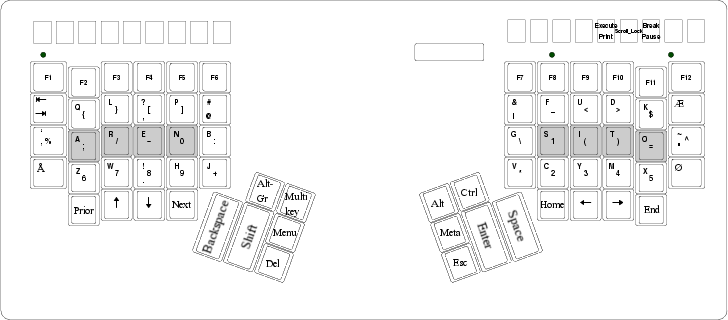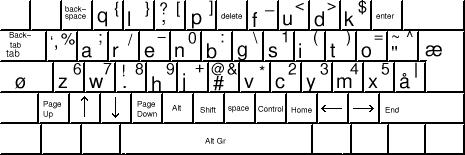The Arensito Keyboard Layout
If you are interested in how the arensito was designed, see the development of the arensito. Here you will also be able to view the layout using gimp's layers, and download the layout to try this baby for yourself.
I have been using the arensito letter layout since 1. of January 2001, and would have to say that it is very comfortable. Arensito consists of
- The arensito letter layout
- This consists of the unshifted and shifted keys. The layout is
q l p f u d k a r e n b g s i t o z w h j v c y m xThis unique placement of the letters :- Places the eight most used characters under your fingertips.
- Is the layout that minimizes the probability that you use the same finger twice (in succession).
- Is the layout that maximizes the probability for using neighbour fingers in succession (and keeps the probability of sequences like y-d or z-l diminishingly low). This lets the fingers strike diagraphs and trigraphs extremely fast.
- Keep the workload off the pinkies. Both pinkies press a button about 40% less than the other fingers.
- The "programming" characters layout
- This consists of all non-letters like digits, (, / , ;,
... etc. They are accessed using the AltGr key :
{ } [ ] _ < > $ ; / - 0 : \ 1 ( ) = 6 7 8 9 + * 2 3 4 5This places the most used characters in programs under your fingertips, and manages to keep the layout easy to remember. - The special keys layout
- The special keys consists of the arrow keys, modifier keys,
backspace, space, return, ... etc. What I have thought of so far
is that the keys
PgUp Up Down PgDown Home LArrow RArrow Endshould be administered by the fingers (currently in that order), while some or all ofSpace, Shift, AltGr, Control, Alt, Enter, BackSpace, Delete, Tab, Escapeshould be placed under the thumbs.
Note that these layouts are mostly independent, thus it would be possible to allow for the arensito letter layout with the standard qwerty/dvorak programming character row on the top.
The layout has to be implemented on a keyboard, and I am sorry to say that the physical constraints of the standard keyboard makes this impossible. The reasons are
- The keys are not fitted to the fingers physiology. The keys are not even laid down in straight columns and rows, but rather in an angled fashion with no mirror symmetry.
- There are only one key for the thumbs to access. The thumbs dexterity should make them handle about 4 keys each(?).
Implementing the Layout
The ideal keyboard for arensito is something like the Kinesis or Maltron keyboards, but the normal keyboard is more accessible and a lot cheaper.
Kinesis Implementation
I have been using the Kinesis keyboard since since the fall of 2001. The following shows the layout:

If you want to try this layout, you should download arensito-kinesis.xmodmap
and run xmodmap arensito-kinesis.xmodmap.
The more permanent solution is to install the layout as an X Keyboard
Extension. Copy arensito-kinesis.xkb
to /etc/X11/xkb/keymap/. Then edit the InputDevice
section of /etc/X11/XF86Config by removing the XkbRules-,
XkbModel-, XkbLayout- and XkbVariant- options, and adding a line
Option "XkbKeymap" "arensito-kinesis.xkb".
Standard Qwerty Keyboard Implementation
The most common, easy and cheapest way to try the arensito is to use an .Xmodmap file for a standard keyboard. The keys backspace and return are accessed by the pinkies, but Alt, Shift, Space, Control and AltGr are under the thumbs:

Jim A. Maxwell made a fantastic applet that let you compare qwerty and dvorak. Fortunately he has made the source files publicly available, so I could include the arensito layout in the comparison (though all non-letters are now excluded from the comparisons.)

